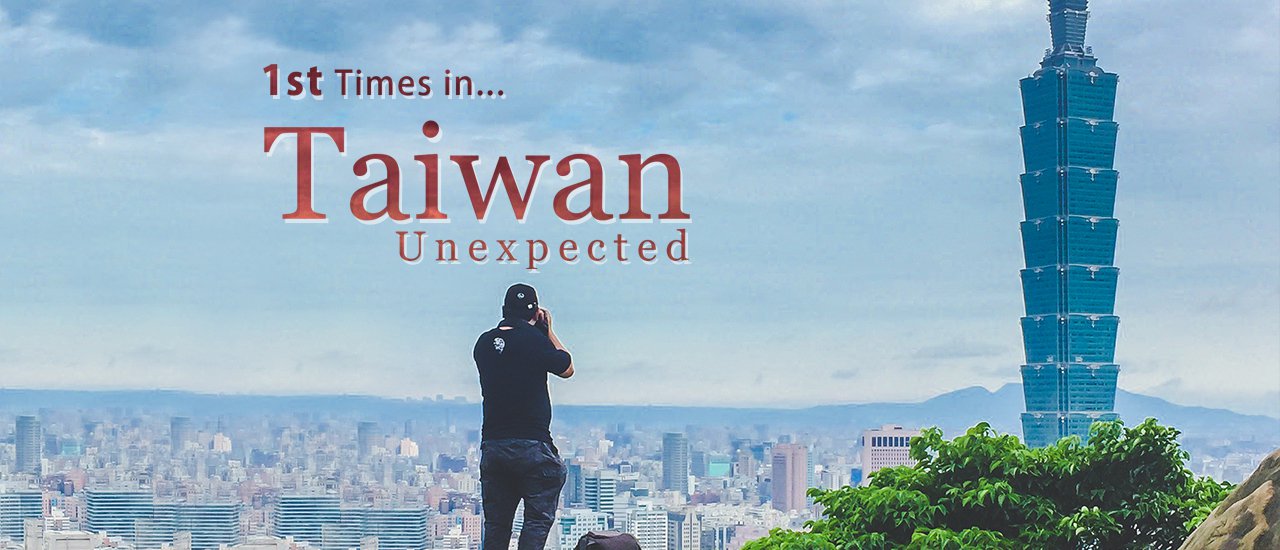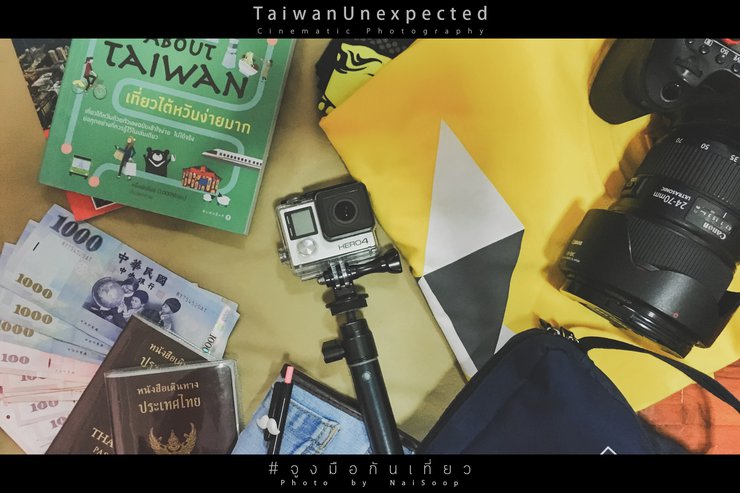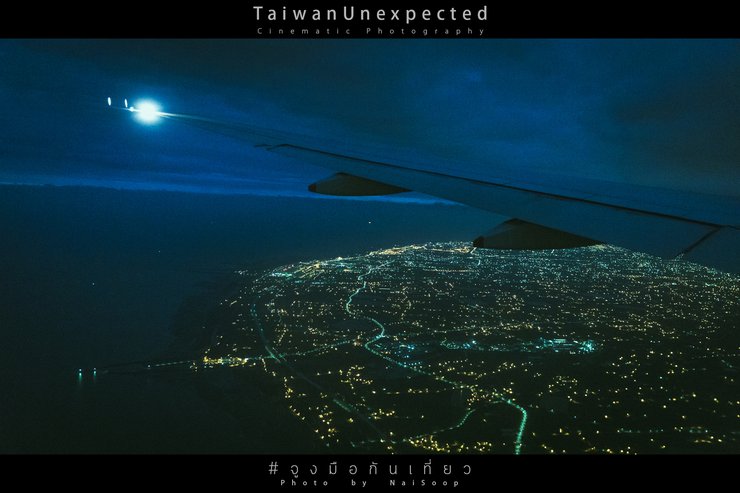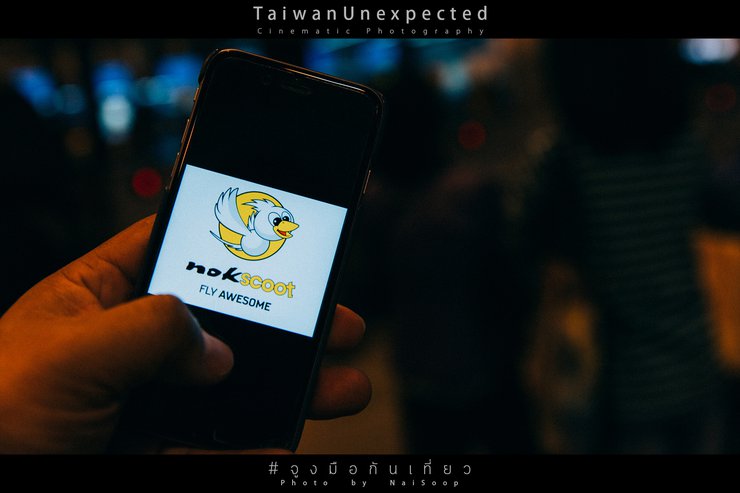"Taiwan", a small island nation located next to China, resembles a sweet potato in shape. It has become a popular tourist destination for Thai travelers, and it might seem a bit embarrassing to admit that this trip was my first visit to Taiwan. However, I must confess that I went with "no expectations" due to the short duration of the trip, which was only 3 days and 3 nights (plus 1 morning).
Cinematic Photography in Taiwan: Unexpected Discoveries
This section will explore Taiwan through the lens of cinematic photography, capturing its unexpected beauty and hidden gems.
Inspired by a friend's passion for Taiwan, I eagerly awaited the opportunity to experience its wonders. The chance arose with a NokScoot flight deal for May 26-29, 2017. After booking, the first step was **"preparation"**:
- **Currency exchange**: The Taiwanese dollar (NT$) fluctuates between 1.14 and 1.16 baht, making calculations straightforward.
- **Researching destinations**: Our itinerary started at 2 AM in Thailand, arriving in Taiwan at 6 AM, allowing for immediate exploration. However, the return flight departed early at 9 AM, essentially limiting the final day to airport travel. This constraint resulted in a 3-day trip focused solely on Taipei.
- **Camera preparation**: Taiwan's island geography, similar to Japan, brings unpredictable showers even during summer. With weather forecasts unreliable, avoiding storms became the priority. In addition to the main camera, an action camera was essential for braving the rain.

This trip, we booked a promotion from Nok Scoot Airlines, which offered a very good price. The round-trip fare per person was around 4,500 baht. We flew on Friday and returned on Monday, which was perfect. We had 3 full days to explore.

We departed at 2:00 AM on the 26th (we had been waiting since the night of the 25th, so we were quite sleepy. We slept as soon as we boarded the plane). The total travel time was 4 hours. Taiwan is one hour ahead of us. If you want to set the time zone of your watch, you can use Hong Kong's time zone. This is the first picture I took of Taiwan. Looking down, I was impressed by the fact that almost every road I could see had lights on, even in the countryside.

After collecting your luggage at the baggage claim, you will need to travel into the city. There are many ways to get into the city, but the most convenient option is to take the Airport MRT. This will take you directly to Taipei Main Station.
Fortunately, when we went, the One Day Pass was on sale, buy one get one free. Instead of paying 700 NT$, we only paid 350 NT$, which was only 175 NT$ per person. As for why we bought the One Day Pass, I'll explain later.

The interior of the train is similar to other electric trains, with designated areas for luggage storage (although the space may seem limited). This particular train is a regular service, not an express train. A notable advantage of the train system is the availability of free Wi-Fi. Additionally, the train's speed is impressive, allowing for seamless use of Google Maps.

Our initial impressions of Taiwan mirrored those of a wide-eyed child, captivated by the novelty of our surroundings. The island's mountainous terrain, encompassing two-thirds of its landmass, was particularly striking. Despite the mountainous landscape, we observed a well-organized infrastructure, with factories strategically positioned along the slopes. As we ventured further inland, industrial zones emerged, gradually transitioning into towering buildings and residential areas.


Upon arrival, we first checked our luggage at our accommodation for the trip, a hostel called "Muiu Capsule Inn Taipei." (For a brief review of the hostel, please refer to MUIU Capsule Inn: A Charming Hostel in the Heart of Taipei).
We left our luggage at the hotel before checking in, as check-in wasn't until 3 pm (this seems to be the standard check-in time in most places). This photo shows our room, a twin room with bunk beds. We took the photo upon check-in. The room isn't very spacious, but it's sufficient if you don't have a lot of luggage.

The journey begins...
The urban landscape of Taipei resembles that of Hong Kong, but with less congestion and a more pedestrian-friendly layout. The city features a grid-like street plan, making navigation easy. Vehicles drive on the left side of the road, which can be initially disorienting, especially when turning. Traffic signals are not strictly enforced, but drivers generally stop for pedestrians crossing the street (a common courtesy observed in most places except for my own country). Motorcycles are popular in Taipei, but they are mostly small scooters that travel at moderate speeds. Unlike in my country, reckless young riders are rarely seen here. A unique feature of Taipei's streets is the covered walkways that extend over sidewalks, providing shelter from the elements and maximizing space utilization. This allows for comfortable walking even during rainy weather.

The subway here is not very crowded in the morning, probably because it is still early and there are not many people. The interior of the carriages is fairly clean, but it shows signs of wear and tear. Many Taiwanese people are also glued to their social media, just like in Thailand. This is one aspect where I don't see much difference between the two countries.

Longshan Temple
Longshan Temple
Our first stop is **Longshan Temple**, a renowned temple where visitors come to pray for good fortune. Easily accessible via the blue MRT line (BL – Bannan Line), alight at Longshan Temple Station (BL10) and take Exit 1.
Upon exiting the station, one is immediately immersed in the local way of life. People gather to chat, play chess, or even make the space their semi-permanent residence.


The sky is overcast today, but there is no sign of rain. The majestic dragon-patterned gate and colorful tiles stand out prominently. Longhshan Temple is one of the most sacred and oldest temples in Taipei. It was destroyed by bombs during World War II but was extensively restored with the help of master craftsmen, returning it to its former glory. The temple's sacred object is the statue of the Goddess of Mercy, which was almost undamaged by the bomb, even though the surrounding area was completely destroyed. (If we compare it to our country, it would be like the Leng Noei Yi Temple in Yaowarat.)

The ritual of paying respects to the sacred objects here follows a fixed pattern: enter through the right-hand door and exit through the left-hand door. The incense sticks here are quite long; at first, I wondered how long they could possibly be.

The length of incense sticks is determined by the cultural practice of using them in conjunction with incense pots. The long length allows for the incense stick to be placed in the pot without the risk of the user being burned by the lit end. Different cultures have developed their own unique customs and traditions surrounding the use of incense.

Despite the diverse practices observed, such as variations in bowing directions and incense holding, everyone present approached the deity with reverence and devotion.



Bicycle rentals are a common sight at almost every power station. You can borrow a bike at one station and return it at another. The service is also inexpensive, costing only a few dollars. Their roads are designed to be comfortable for cyclists. In Thailand, we have also seen the emergence of bicycle rentals, but the main factor is that the roads are not yet very conducive.

We opted for the Taoyuan Airport MRT One Day Pass because our primary objective was to shop at Mitsui Outlet Park Linkou. Due to our limited time, stopping by on our return trip was not feasible. Therefore, we decided to shop on one of our initial days, as we were not changing accommodations and wouldn't have to carry our luggage around. While visiting on the return trip is also an option, it might be inconvenient due to packing requirements.
If you are taking an express train (the seats and station signs will be different from regular trains), get off at Chang Gung Memorial Hospital Station (A8). Then, transfer to a regular train and get off at the next station, Linkou (A9). From there, it is a short walk to the outlet. Alternatively, you can wait for the outlet's shuttle bus.

After the outlet, we returned to our accommodation to collect our belongings before heading to Ximending, a convenient late-night shopping and entertainment district. It could be compared to Siam Square in Thailand, but with the added benefit of being open until late. This makes Taipei a truly 24-hour city. Ximending offers a diverse range of restaurants, fashion stores, and even cinemas, making it a popular destination for both tourists and locals alike.



Mala Yuanyang Hotpot, Taipei
Spicy鸳鸯火锅, Taipei
Taiwanese hot pot (Mala Hotpot), a famous Taiwanese dish. I tried it myself and it's no wonder why people recommend trying it at least once. The restaurant we tried is called Mala Yuanyang Hotpot, located in Ximenting. I can only say that it's "amazing" because it's a hot pot buffet that we spent the full 2 hours and still felt like it wasn't enough. It's the first time I've seen a buffet that serves Angus beef. By the time I realized it, I had already eaten 3 trays. I missed the chance to eat it again because the next day was fully booked and I had to go back... I didn't make it in time. I posted about it once before, you can check it out here....
https://www.facebook.com/naisoop/posts/858930510948505



Chiang Kai-Shek Memorial Hall
We left our accommodation early in the morning to capture the morning view here. The journey was not difficult. From Taipei Main Station, take the **red line (Tamsui-Xinyi Line) to C.K.S. Memorial Hall Station**. Take exit 5. It is a large memorial site with a wide area. In the same area, there is also a building for concerts and the National Theater. The monument is a large building located in the center at the back.


A popular attraction for tourists is the hourly changing of the guard ceremony at the memorial. The ceremony is a visually impressive and dignified event, adding to the site's allure. It is recommended to arrive early and secure a good viewing spot, as the area is cordoned off before the ceremony. The guards emerge from a side gate to relieve the existing guards. (Fortunately, I was directed to this spot.)



Shilin Night Market (士林夜市)
After visiting the Chiang Kai-shek Memorial in the morning, we were unable to venture further due to the persistent rain throughout the afternoon. Our original plans were dashed, forcing us to seek shelter from the downpour. It wasn't until the evening that we were able to take out our cameras and capture some shots. With our initial plan of ascending Elephant Hill thwarted, we opted for a nighttime shopping spree instead (yes, more shopping!). Getting there was a breeze: simply hop on the Red Line (Tamsui-Xinyi Line) and alight at Jiantan Station, Exit 1.
Shilin Night Market is a bustling night market that comes alive around 5 pm and stays open until midnight. It offers a wide variety of food, non-branded shopping options, and even some branded items like shoes and clothing. However, the market is most famous for its diverse street food, with stalls lining the streets. To easily identify the market, look for the orange building at the intersection after exiting the MRT station. Street food stalls are mainly located on the left side, while shops are on the right. Don't worry if you choose one side, as there is a market at the end that connects both sides.

Let's take a look at some of the delicious food available. This is just a small sample of what's on offer, but it's sure to leave you feeling satisfied.
Stinky Tofu (35 NT$)
Our first dish is the restaurant's signature dish, known for its unique and pungent aroma. While some diners describe it as crispy and surprisingly pleasant, I personally found the smell unappealing. However, my partner enjoyed it thoroughly, so it's a matter of personal preference. (No worries, my partner handled this dish with gusto!)

Grilled Angus Beef (100-200 NT$)
This ubiquitous franchise (with at least three outlets in this market alone) features large chunks of Angus beef grilled over an open flame. The meat is gradually cooked and then diced into cubes, packaged in two sizes: small and large. Customers can choose from a variety of seasoning powders, including the "Spicy" option, which is essentially a chili powder blend. For meat lovers, this is a decent option that offers a satisfying snack, especially when paired with a cold beer.

Takoyaki Cheese (100 NT$)
Takoyaki filled with large, bite-sized pieces of octopus, even small ones, with overflowing ingredients and a performance that makes you want to try it. Compared to what I've eaten before, it's similar to Osaka-style takoyaki, which is not crispy but has a soft texture, unlike the crispy batter of dango. A box contains 6-8 balls.

Bitter Melon Juice (60 NT$)
If you see white bitter melon hanging in front of a shop, that means they sell sweet bitter melon juice. I tried it and liked it. It's not too sweet, and it has a cool aftertaste with a slight bitterness at the end. It's not as bitter as the bitter melon we have at home, so it's easy to drink.

Hot Star Fried Chicken
A renowned fried chicken restaurant has opened in Thailand. This photo shows the restaurant, but I didn't eat there because the portions are so large that I wouldn't have been able to try anything else. The lines were also very long.

Grilled Giant Squid Skewer (100 NT$)
Initially, I believed it was grilled chicken on a stick with barbecue sauce, so I waited in line for a long time. The restaurant had no pictures or English descriptions. I only realized it was not chicken when I took the first bite. It was unexpectedly tough and could not compete with our local seafood dipping sauce. It might be giant squid, which could be acceptable for some people, but it was not for me.

Fish balls in broth (50 NT$ for 2 skewers)
Steaming hot fish balls are available in two varieties: plain broth and (yet again) mala soup. They are sold simply; choose your desired flavor and sprinkle with an unknown green powder followed by pepper. Initially, I misread the sign and thought they were 10 NT$ per skewer, but they were actually 25 NT$ each. We decided to try them anyway. In my opinion, the Thai version is tastier, but this skewer was surprisingly spicy, likely due to their pepper. We had to grab some water to cool down our tongues.

The local cuisine is incredibly diverse, and listing everything would be an extensive task.
Let's put the food aside for now and see what else this market has to offer. Besides the usual shops and stalls, there are also games to play, similar to those found at temple fairs in Thailand. These include balloon darts, bingo, and fishing for ping pong balls. As for the shops, they sell a variety of interesting items, some of which are handmade. There are plenty of fashion items to browse through, and we ended up walking around until almost midnight. By the way, the subway here closes at midnight, but be sure to check the last train times for your station.




Elephant Mountain (Hiking Elephant Mountain for a View of Taipei 101)
On the third day, we set out early in the morning to catch the first train. Our goal was to hike up Elephant Mountain to take pictures of Taipei 101. We wanted to make up for not being able to go up the previous evening. We had to start early to avoid the heat and to catch some beautiful light. Another advantage of starting early was that we got to see some sights that are not usually seen during the day.


Getting there is not difficult. Take the **red line (Tamsui-Xinyi Line)** to **Xiangshan Station**, the last stop. Then walk for about 800 meters to the entrance of Elephant Mountain. The path is a concrete staircase, which is easy to walk on. However, it is still tiring. We saw elderly people overtaking us slowly... It's okay, we are in no hurry. After walking up for about 400-600 meters (according to Google Map), you will reach a scenic spot called **The Six Giant Rocks**, which are six large rocks that many people climb to take pictures (the same picture as the cover). But if you want a view where you can sit comfortably and enjoy the view, go up a little further. There is a large open space where you can rest and enjoy the view of Taipei City and Taipei 101. I took many pictures, but this is the one I chose... It took us a total of 2 hours. **
**

Hsing Tian Kong Temple
The Xingtian Temple is a popular destination for Taiwanese people to pray for career success, stability, and financial fortune. The temple holds group prayer ceremonies, and it is often crowded with visitors. To reach the temple, take the orange line (Zhonghe-Xinlu Line) of the Taipei Metro and get off at Xingtian Temple Station. Use Exit 3 and walk straight ahead, then turn right after crossing the street. The temple will be on your right.


Taipei Fish Market (Addiction Aquatic Development (AAD))
To reach this market, continue your journey from Wat Sing Tian Kong. Follow the directions provided by Google Maps. The journey takes approximately 10 minutes, covering a distance of around 700 meters.
The Taipei New Fish Market operates like a supermarket for fresh seafood. Customers can purchase raw ingredients for cooking or opt for ready-to-eat sashimi. While the prices are not exactly cheap, they are considered reasonable compared to similar offerings in Thailand. For those seeking even lower prices and a more authentic market experience, the outdoor market offers a viable alternative. The New Fish Market caters primarily to individuals who prioritize convenience.

Bent Mailbox (彎腰郵筒)
The next destination I wanted to capture was the iconic "Leaning Mailbox." From the fish market, I could have taken the train back, but since I was in Taiwan, I decided to try a taxi for the first time. The distance wasn't too far, and Taiwanese taxis are another symbol of the city. In Taipei, the starting fare for a taxi is 70 NT$ for the first 1.25 kilometers, and then it increases by 5 NT$ for every 200 meters.

The Leaning Mailbox: A Taiwanese Landmark
This peculiar mailbox stands bent at an awkward angle, a testament to the power of Typhoon Soudelor that struck Taiwan two years ago. The storm's ferocity, strong enough to lift entire motorcycles, also brought down shop signs and billboards, one of which struck the mailbox.
Following the storm, authorities assessed the damage and deemed the mailbox beyond repair. However, this unexpected turn of events led to the creation of a new Taiwanese landmark. Initially, queues formed as people waited to capture the unique sight. While the crowds have thinned, capturing the perfect photo still requires a bit of luck, as parked cars occasionally obstruct the view.

Taipei 101 Observatory & Din Tai Fung
This sentence describes two popular tourist destinations in Taipei, Taiwan: the Taipei 101 Observatory and Din Tai Fung.
- Taipei 101 Observatory: Located on the 89th floor of the iconic Taipei 101 skyscraper, the observatory offers breathtaking panoramic views of the city and surrounding areas.
- Din Tai Fung: A world-renowned restaurant chain specializing in Taiwanese cuisine, particularly famous for its Xiao Long Bao (soup dumplings).
This sentence suggests a potential itinerary for tourists visiting Taipei, combining a cultural experience with a culinary delight.
Our next stop is Taipei 101. Our goal is to dine at Din Tai Fung and enjoy the view from the 89th floor.
Din Tai Fung is a popular restaurant chain that serves a variety of Chinese dishes, including the famous Xiao Long Bao. The restaurant is known for its high quality food and service. The restaurant is located in a convenient location and has a large seating area. The restaurant also has a show kitchen where customers can watch the chefs prepare the food.



The ticket booth for the observation deck is located on the 5th floor. Tickets cost approximately 500 USD per person. It is recommended to purchase tickets online using an app, as there may be discount codes available. In our case, we were able to save around 100 USD using a discount code. After purchasing tickets, we joined the queue for the world's fastest elevator. The elevator ride to the 89th floor took approximately 10 seconds. Upon reaching the observation deck, we were able to walk around all four sides. The most scenic view was arguably the side offering a view of the sunset. Fortunately, we were able to witness sunlight breaking through the clouds, making the experience truly worthwhile.


Our three-day, three-night trip to Taipei felt too short. There were still many places we wanted to visit, and even the places we did visit, we felt we could revisit if given the chance. On our last day, we left our accommodation to catch the first train. We were glad we did, as the check-in process took a considerable amount of time due to the high number of tourists (it's advisable to allow extra time). We even had breakfast at the airport.
This trip was an 8/10 experience. The only drawback was the lack of English menus at some restaurants, making it difficult to order food without knowing Chinese. However, Taipei itself was a joy to explore, with shops and attractions open late into the night. This extended opening hours allowed us to visit other places during the day and still enjoy Taipei's nightlife later in the evening.
Prior to my arrival in Taiwan, it was not a country on my travel list. However, after visiting, I can confidently say that this will not be my last trip. As the saying goes, "Travel is the discovery of new experiences."

Thank you to everyone who has been following along.
If you have any questions or comments, please feel free to ask.
Or you can follow my travels on my fan page at
https://www.facebook.com/naisoop
Or other social media channels
Website: http://www.naisoop.com/
Instagram: https://instagram.com/naisoop
See you again in the next review.
The sentence is already in English and does not require translation.
จูงมือกันเที่ยว by NaiSoop
Tuesday, October 8, 2024 11:22 AM










![Cover [Bag Pack by NaiSoop] Cruise to see the red lotus, ride an e-taek up...](https://asset.readme.me/files/48507/thumb.cover.jpg?v=9b2772b5)



